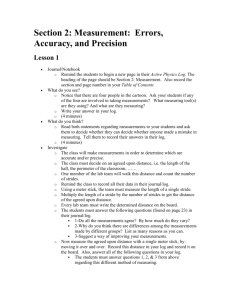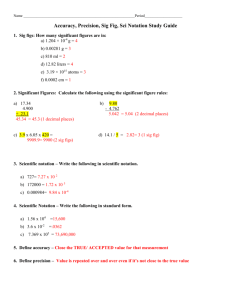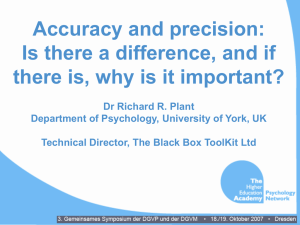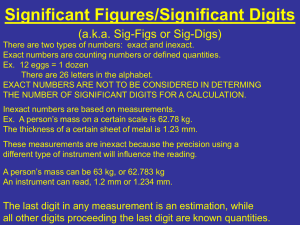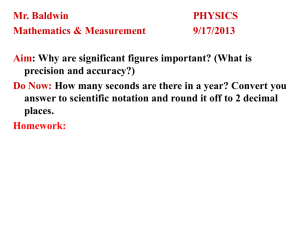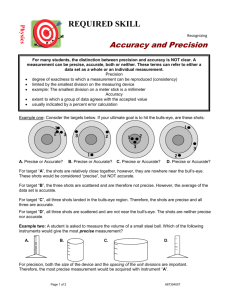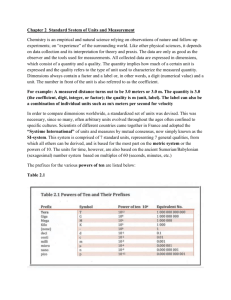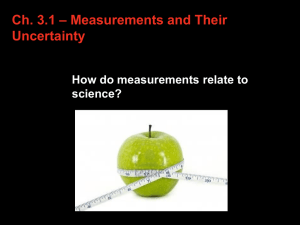Sep 5 - 9 Tues (48 min) Wed (48 min) Thurs (48 min) Thurs Lab (48
advertisement
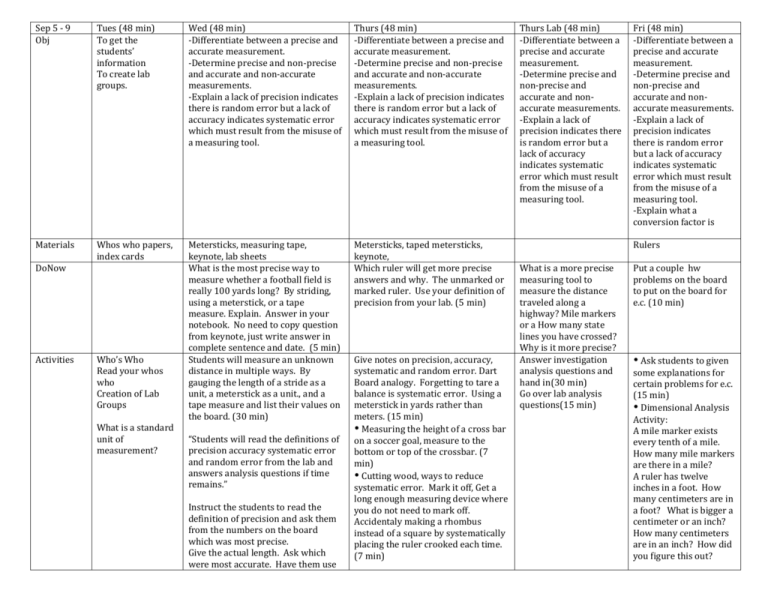
Sep 5 - 9 Obj Tues (48 min) To get the students’ information To create lab groups. Wed (48 min) -Differentiate between a precise and accurate measurement. -Determine precise and non-precise and accurate and non-accurate measurements. -Explain a lack of precision indicates there is random error but a lack of accuracy indicates systematic error which must result from the misuse of a measuring tool. Thurs (48 min) -Differentiate between a precise and accurate measurement. -Determine precise and non-precise and accurate and non-accurate measurements. -Explain a lack of precision indicates there is random error but a lack of accuracy indicates systematic error which must result from the misuse of a measuring tool. Materials Whos who papers, index cards Metersticks, measuring tape, keynote, lab sheets What is the most precise way to measure whether a football field is really 100 yards long? By striding, using a meterstick, or a tape measure. Explain. Answer in your notebook. No need to copy question from keynote, just write answer in complete sentence and date. (5 min) Students will measure an unknown distance in multiple ways. By gauging the length of a stride as a unit, a meterstick as a unit., and a tape measure and list their values on the board. (30 min) Metersticks, taped metersticks, keynote, Which ruler will get more precise answers and why. The unmarked or marked ruler. Use your definition of precision from your lab. (5 min) DoNow Activities Who’s Who Read your whos who Creation of Lab Groups What is a standard unit of measurement? “Students will read the definitions of precision accuracy systematic error and random error from the lab and answers analysis questions if time remains.” Instruct the students to read the definition of precision and ask them from the numbers on the board which was most precise. Give the actual length. Ask which were most accurate. Have them use Give notes on precision, accuracy, systematic and random error. Dart Board analogy. Forgetting to tare a balance is systematic error. Using a meterstick in yards rather than meters. (15 min) Measuring the height of a cross bar on a soccer goal, measure to the bottom or top of the crossbar. (7 min) Cutting wood, ways to reduce systematic error. Mark it off, Get a long enough measuring device where you do not need to mark off. Accidentaly making a rhombus instead of a square by systematically placing the ruler crooked each time. (7 min) Thurs Lab (48 min) -Differentiate between a precise and accurate measurement. -Determine precise and non-precise and accurate and nonaccurate measurements. -Explain a lack of precision indicates there is random error but a lack of accuracy indicates systematic error which must result from the misuse of a measuring tool. Fri (48 min) -Differentiate between a precise and accurate measurement. -Determine precise and non-precise and accurate and nonaccurate measurements. -Explain a lack of precision indicates there is random error but a lack of accuracy indicates systematic error which must result from the misuse of a measuring tool. -Explain what a conversion factor is Rulers What is a more precise measuring tool to measure the distance traveled along a highway? Mile markers or a How many state lines you have crossed? Why is it more precise? Answer investigation analysis questions and hand in(30 min) Go over lab analysis questions(15 min) Put a couple hw problems on the board to put on the board for e.c. (10 min) Ask students to given some explanations for certain problems for e.c. (15 min) Dimensional Analysis Activity: A mile marker exists every tenth of a mile. How many mile markers are there in a mile? A ruler has twelve inches in a foot. How many centimeters are in a foot? What is bigger a centimeter or an inch? How many centimeters are in an inch? How did you figure this out? the definition of precision and accuracy. Which contained more random error? Did any contain systematic error. Probably not, but how may systematic error enter in. Draw on board how one may measure too far each time. (back to front) (15 min) Random error. Which ruler will Assessment Discussion at the end of class based on the definitions Discussion. HW Lab Due Friday How long is your desk in feet, centimeters, inches? Does this makes sense based on the number of centimeters you said are in a foot? (15 min) Go over activity (8 min) measure the length of the desk better? The taped one or the marked one. Have students close their eyes while 3 students measure the length of my desk and write it on the board. They will secretly write down the length using the marked ruler. Now which measuring device was more precise? And which introduced more random error? (14 min) Discussion. Take points off their lab if they are not working. – Problem Set on Accuracy and Precision Due Monday, HW Quiz Monday. Going over it tomorrow. You can put a problem on the board or explain a problem for extra credit. Hand in activity to be graded and hand back to them tomorrow. Problem Set on Accuracy and Precision Due Monday, HW Quiz Monday. Objectives: SWBAT… Differentiate between a precise and accurate measurement. Determine precise and non-precise and accurate and non-accurate measurements. Indicate a lack of precision indicates there is random error but a lack of accuracy indicates systematic error which must result from the misuse of a measuring tool. Memorize the SI unit for distance, time, mass. Memorize meaning of prefixes mili, centi, kilo Use a conversion factor to convert distances, times, and masses between metric and English units 1 step, then 2 step Explain that converting between units does not change the amount of systematic or random error contained within the original measurements.
